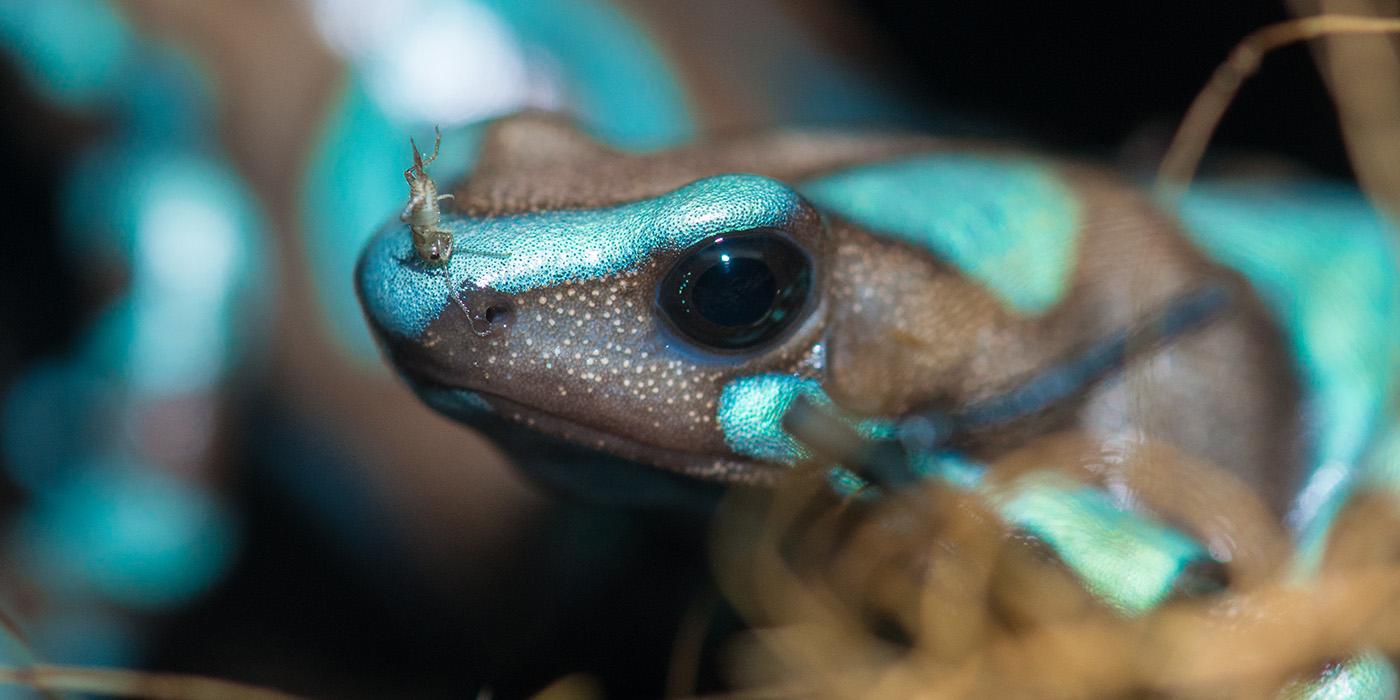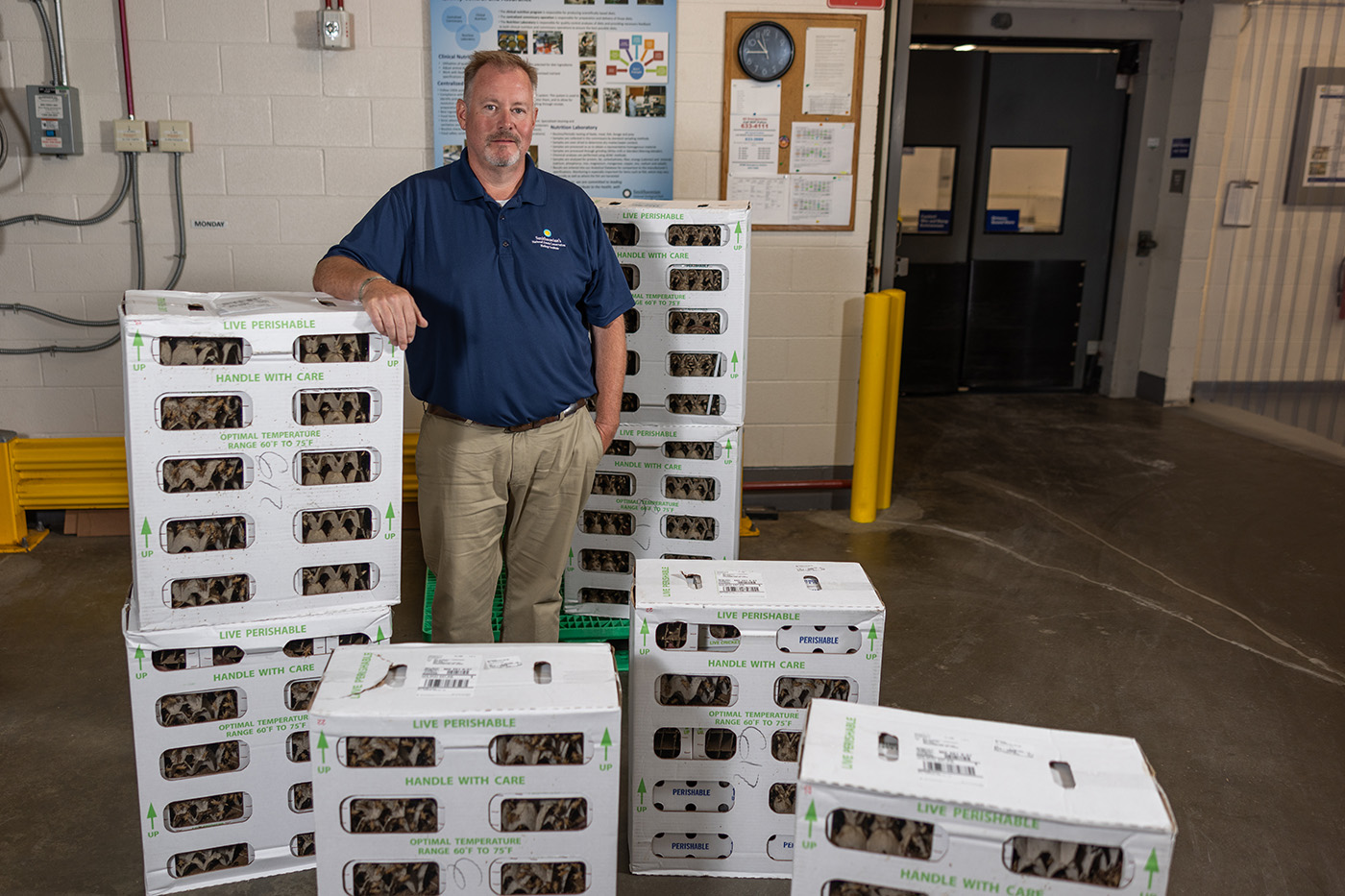Body by Bugs: How the Zoo Feeds Insect-Eating Animals
For the Zoo’s insect-eating residents, no meal is complete without live, nutrient-packed bugs

If you’re walking down the aisles of a health food store or an organic food market, you might notice a cricket protein bar on the shelves, or maybe a bag of chips made from insect flour.
But live bugs for lunch?
No, they’re not part of some new diet plan to help you attain the ultimate summer beach body. They’re a nutritious, affordable, and always-in-demand snack for the animal residents at the Smithsonian’s National Zoo and Conservation Biology Institute.
The zoo behind the zoo
Many animals at the Zoo chow down on insects, including birds (cranes, songbirds, ducks), amphibians (poison frogs, tree frogs, salamanders), fish (tetras, cichlids, arowanas), small mammals (skunks, armadillos, marmosets), and even larger mammals (sloth bears, otters and primates.)
A mind-boggling number of bugs are consumed by the Zoo’s insectivores, or insect-eating animals, each week: 121,000 crickets, 150,000 mealworms and 17,000 waxworms, not including thousands of other non-insect invertebrates, like earthworms and springtails. Put differently, the Zoo’s animals go through about 80 pounds (36 kilograms) of crickets and about 30 pounds (13 kilograms) of mealworms each week. Combined, that's roughly the weight of a small human adult.
“Insects provide a great source of protein and calcium, which animals need to stay healthy,” said Bill Clements, who manages the Zoo’s commissary. “Plus, foraging for the insects is a great source of enrichment. It gives them a chance to practice their natural feeding behaviors, which is important for their well-being.”
A shipment of crickets delivered to the commissary. Each box contains hundreds of crickets.
Delivering food to the Zoo’s animals becomes more trickier when the food has a tendency to crawl, climb, jump and wriggle away. Insect shipments are distributed to the Zoo’s animal areas almost immediately after arrival to prevent the insects from breaking out of their boxes and into the food stores, said Clements.
And because insects are often a daily meal, having a constant supply of crawling critters is essential. Exhibit areas, like the Reptile Discovery Center, Amazonia and the Bird House, maintain small populations of insects behind the scenes.
Keepers provide these colonies with essentially the same levels of care as with any other animal, explains Clements. Biology and welfare must be taken into account.
Cricket colonies, for example, are kept in warm, humid, temperature-controlled environments, since the insects do not use internal energy to generate their own body heat. And mealworms—which are actually the larval form of the darkling beetle—are stored in grain meal, which provides both shelter and food.
Before being delivered to the Zoo’s animals, crickets are supplied with a fortified diet to increase their nutritional value.
Staff also make sure the insects are packed with high-quality food, so they have higher nutritional value. Keepers feed the crickets a high-calcium commercial insect grain meal, often paired with fruits and vegetables for additional vitamins and minerals.
While most of the crickets are ordered from commercial vendors specialized in growing feeder insects, it’s important for the Zoo to be able to grow their own supply, too. Not only are breeding colonies a useful way to help meet demand, but insects also have different uses depending on their stage in the life cycle.
Donna Stockton, an entomologist and animal keeper at Amazonia, poses with mealworms, waxworms, live crickets, cockroaches and other invertebrate specimens.
The poison frogs living in Amazonia, for example, regularly reproduce and have babies as part of the Zoo’s breeding program. After metamorphizing from tadpoles, the froglets are tiny—just a few millimeters long—which means the insects they eat must be small enough that the amphibians can easily consume them.
So Amazonia staff, like keeper Donna Stockton, make sure the crickets in the colony are set up with the right conditions to breed. The crickets lay eggs in soil-filled containers, which are kept warm as the eggs incubate. After about two weeks, the newborn crickets emerge, and are so small that they can safely be eaten by tadpoles and small frogs.
Part of a balanced diet
At the commissary, staff work together to make create and deliver balanced, healthy meals for each of the Zoo’s 2,100 animals in the park—even if wrangling hordes of wriggling, jumping, squirmy bugs makes dining at the Zoo is a complicated endeavor.
Dietary plans are carefully calculated by Department of Nutrition staff. By examining what each animal consumes in its natural environment, the team figures out how to most closely match that diet in the Zoo. Because so many wild animals consider insects to be an essential part of a balanced diet, animal care teams provide the Zoo’s animals with a steady supply of crickets, mealworms, waxworms and other insects to chow down on.
Part of Clements’ job is to ensure each animal is supplied with the right amount of food every day, 7 days a week, 365 days per year. He and the commissary team order, prepare, sort and deliver a constant supply of insects to the Zoo’s behind-the-scenes areas ahead of the animals’ mealtimes.

Bill Clements, manager of the Zoo’s commissary, leads a team of staff members who receive, organize, track and deliver food shipments to animals throughout the park.
Mealtime can range from simple to complicated, depending on the dietary needs of the animals involved.
For some species, like the dozens of migratory songbirds at the Bird House, insects must be precisely weighed to account for seasonal changes in the birds’ diets. Others, like the Asia Trail’s three sloth bears, are each served big scoops full of mealworms.
Once you pop, the fun don’t stop
Because many animals in the wild spend much of their time foraging for food, the Zoo uses insect feedings as enrichment opportunities. Keepers may place insects throughout an insectivore’s habitat area or hide insects inside objects the animals must work to get into. The armadillos and skunks living at the Small Mammal House, for example, find and eat mealworms hidden inside of toys.
And just like humans, animals need some variety in their diets, explains Stockton.
In addition to crickets, the amphibians at Amazonia might eat bean beetles, which are tiny insects that can found living in cupboards among jars of dried beans, or fruit flies, which are notable for their rapid reproduction and brief lifespans. On the occasions when the amphibians at Amazonia don’t seem interested in crickets, crunchy bean beetles or fruit flies, might be a nice change of pace, she said.
The Science Behind Animal Snacks
How do you create a menu that is pleasing to the palates of giant pandas, flamingos and fishing cats?



